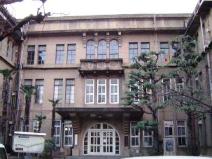Decoding Kyoto 2007
This website tells you about Kiyamachi,one of the oldest entertainment districts in Kyoto.
You can learn about its interesting history.
You can know about many eating and drinking places from famous Japanese cuisine restaurants to popular bars.
After learning, all you have to do is COME and ENJOY YOURSELF!!
Historical Site
①The remains of Kousatsu place (高札場跡)
Kousatuba was the place where the Shogunate government in the Edo period put up a bulletin board. Information about laws, rules and crimes were written on Kosatsu (a bulletin board) that was built in a public space to let the people know them.
②The remains of the Ikedaya Incident (池田屋騒動之址)

The Ikedaya Incident was an armed encounter where Shinsengumi, a police force of the Shogunate, slew 9 samurai and caught 23 samurai including Teizou Miyabe and others, who gathered and framed a plot against the Tokugawa Shogunate at the Soubei Ikedaya’s inn. The incident began when Shinsengumi caught Shuntarou Furutaka in the first year of Genji (1864). Shinsengumi forced him to confess that the group revering the Emperor and aiming to expel foreigners, composed of samurai warriors from such Domains (Han) as Choshu, Tosa and Higo, had been planning a plot. Shinsengumi knew beforehand the plot was in action at Ikedaya.
③The place where Ryoma Sakamoto’s temporary residence existed
(坂本龍馬寓居之址)

There was a very famous vinegar shop at the place remembered in connection with Ryoma Sakamoto and the Kaientai, a trading company that Sakamoto set up. There were a shed and Domain residences near the shop. So this shop was a very convenient place to negotiate with Domains and also travel to Fushimi, a commercial area located in the south part of Kyoto. The master approved Ryoma's ambition and was willing to cooperate with his activity.

④The place where Shojiro Goto's temporary residence existed
(後藤象二郎寓居之跡)
Shojiro Goto was a samurai warrior of the Tosa Domain learned in politics. He became a chief retainer in Keio 3 (1867). After a few months, he came to Tokyo and stayed at a pot shop. He thought of reconciliation of Imperial Court and the Shogunate. Being enlightened by Ryoma Sakamoto and his idea, Goto persuaded Yodo Yamanouchi to permit Shogun Yoshinobu Tokugawa to hand over political power to Imperial Court. He attended to government after the Meiji Restoration.
⑤Former site of the Hikone Domain House (彦根藩邸跡)

There had been the Hikone Domain’s residence in Kyoto in this area for seventeen years since the year after the arrival of the U.S. Admiral Matthew C. Perry. Takasegawa River runs the east side of the residence. The total area of this site amounted to 3,500㎡, and the total area of the residence was about 2,400㎡.
⑥Former site of temporary residence of Oushu Nakai (Hiromu Nakai)(中井桜洲寓居之跡)
This is the former site of temporary residence of Oushu Nakai (also called Hiromu Nakai) who was a samurai of Satsuma area. He went to England and studied there supported by Shojiro Goto. At the last days of the Tokugawa Shogunate, he lived in Kiyamachi and associated with some other samurais. After the Meiji Restoration, he served in the Government. Eventually he became governor of Kyoto Prefecture in 1893.
⑦Former site of the Tosa Domain House (土佐藩邸跡)

This is the former site of Tosa Domain House which was confiscated by the government and became private property in 1871. In 1881, Akashi Hiroakira, a business man, opened a hot spring named “Kyoka-Onsen” here. Then, in 1891, it became a high class Japanese-style restaurant “Kyorakukan.” After Kyoto Electric Corp. bought this place in 1897, some cinemas were played to test a projector imported from France.

In 1927, a new schoolhouse of Rissei Elementary School was built here, moved from the neighborhood. After the closing of this school in 1993 because of decreased number of pupils, the building is now used as the second facilities of nearby Takakura Elementary School.
⑧The place where Ryoma Sakamoto and Shintaro Nakaoka were assassinated(坂本龍馬、中岡慎太郎遭難之地)
In third year of Keio (1867), while visiting a soy sauce shop master, Ryoma Sakamoto and Shintaro Nakaoka were killed by the Kyoto-Mimawarigumi led by Tadazaburo Sasaki, a group of samurai warriors who policed the anti-Shogunate movement. There has been a debate as to this affair which is still enigmatic.
⑨The place where Seiichiro Honma's temporary residence existed
(本間精一郎寓居之址)

Seiichiiro Honma was a samurai warrior born in Echigo, present Niigata Prefecture. He was a radical revolutionalist defending the Emperor against the Bakufu, Shogunate government. Stuck in dilemma among powers, the Shogunate, the Imperial Court, Satsuma, Choshu, and Tosa, he was treated very badly by them. He became alcoholic and his statement more extreme. Eventually he was murdered under Hanpeita Takechi's direction.
⑩Former site of temporary residence of Sukegoro Miyagawa
(宮川助五郎寓居之跡)

Sukegoro Miyagawa joined the Son-no Joi movement and resisted the Tokugawa Shogunate. In 1866, he tried to remove a bulletin board put up by the Shogunate near the Sanjo-ohashi Bridge, but his attempt was unsuccessful. He was found by members of Shinsengumi on patrol, and finally was arrested by them as a mutineer.
⑪Former site of temporary residence of Shintaro Nakaoka
(中岡慎太郎 寓居之地)
This is the former site of the bookstore where Shintaro Nakaoka temporarily lived in 1860's. Sintaro Nakaoka was a samurai, who contributed to conclusion of Satsuma-Choshu alliance. He secretly lived here and acted against the Shogunate when he came to Kyoto.
⑫Former site of temporary residence of Shuntaro Furutaka
(古高俊太郎 寓居之後)
This is the place where Shuntaro Furutaka’s temporary residence existed. Shuntaro Furutaka was a feudatory of Bishamon-do, one of the temples in Kyoto. He disguised his name as Kiemon Yuasa, and secretly carried on a movement for reverence for the Emperor. His comrades gathered at his house and plotted to rebel against the Tokugawa Shogunate. One day a follower of Teizo Miyabe, one of his comrades, was caught by Shinsengumi, and finally confessed to them about campaigners hiding at the house of Furutaka. Then Furutaka was caught and tortured by Shinsengumi, and then he confessed the conspiracy of campaigners. His confession led to the Ikedaya Incident on June 5, 1864.
⑬Former site of the House of Kanbei Shioya (塩屋勘兵衛宅跡)
Kanbei Shioya was a person who lived in Kyoto in the last days of the Tokugawa Shogunate. He was worried about the ruined conditions of sanryo, the Imperial mausoleum, because he had strong faith in Emperor. Then he conducted research and field work on sanryo. Finally he wrote a great report about sanryo called “Sanryo-Taizen.”